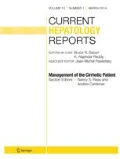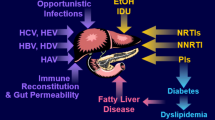Abstract
Coinfection with hepatitis C virus (HCV) is common in HIV-infected individuals, presumably because of the shared route of transmission of these viruses. Highly active antiretroviral therapy has made liver disease caused by HCV a predominant cause of morbidity and mortality among coinfected patients. Patients with HIV infection therefore should be evaluated for the presence of HCV. If the patient is found to be coinfected, a multidisciplinary team should determine whether the individual is a candidate for treatment with pegylated interferon and ribavirin. This article details the principles of successful management of this challenging patient population.
Similar content being viewed by others
References and Recommended Reading
Sherman KE, Rouster SD, Chung RT, Rajicic N: Hepatitis C virus prevalence among patients infected with human immunodeficiency virus: a cross-sectional analysis of the US Adult AIDS Clinical Trials Group. Clin Infect Dis 2002, 34:831–837.
Tedaldi EM, Hullsiek KH, Malvestutto CD, et al.: Prevalence and characteristics of hepatitis C virus coinfection in a human immunodeficiency virus clinical trials group: the Terry Beirn Community Programs for Clinical Research on AIDS. Clin Infect Dis 2003, 36:1313–1317.
Sulkowski MS, Thomas DL: Hepatitis C in the HIVinfected person. Ann Intern Med 2003, 138:197–207. Good review.
Bica I, McGovern B, Dhar R, et al.: Increasing mortality due to end-stage liver disease in patients with human immunode- ficiency virus infection. Clin Infect Dis 2001, 32:492–497.
Darby SC, Ewart DW, Giangrande PL, et al.: Mortality from liver cancer and liver disease in haemophilic men and boys in UK given blood products contaminated with hepatitis C. UK Haemophilia Centre Directors’ Organisation. Lancet 1997, 350:1425–1431.
Eyster ME, Diamondstone LS, Lien JM, et al.: Natural history of hepatitis C virus infection in multitransfused hemophiliacs: effect of coinfection with human immunode- ficiency virus. The Multicenter Hemophilia Cohort Study. J Acquir Immune Defic Syndr 1993, 6:602–610.
Eyster ME, Fried MW, Di Bisceglie AM, Goedert JJ: Increasing hepatitis C virus RNA levels in hemophiliacs: relationship to human immunodeficiency virus infection and liver disease. Multicenter Hemophilia Cohort Study. Blood 1994, 84:1020–1023.
Lesens O, Deschenes M, Steben M, et al.: Hepatitis C virus is related to progressive liver disease in human immunodeficiency virus-positive hemophiliacs and should be treated as an opportunistic infection. J Infect Dis 1999, 179:1254–1258.
Pol S, Lamorthe B, Thi NT, et al.: Retrospective analysis of the impact of HIV infection and alcohol use on chronic hepatitis C in a large cohort of drug users. J Hepatol 1998, 28:945–950.
Sherman KE, O’Brien J, Gutierrez AG, et al.: Quantitative evaluation of hepatitis C virus RNA in patients with concurrent human immunodeficiency virus infections. J Clin Microbiol 1993, 31:2679–2682.
Telfer P, Sabin C, Devereux H, et al.: The progression of HCV-associated liver disease in a cohort of haemophilic patients. Br J Haematol 1994, 87:555–561.
Thomas DL, Astemborski J, Vlahov D, et al.: Determinants of the quantity of hepatitis C virus RNA. J Infect Dis 2000, 181:844–851.
Graham CS, Baden LR, Yu E, et al.: Influence of human immunodeficiency virus infection on the course of hepatitis C virus infection: a meta-analysis. Clin Infect Dis 2001, 33:562–569.
Pol S: [Hepatitis C virus and human immunodeficiency virus co-infection] [review] [French]. Gastroenterol Clin Biol 2001, 25(4 suppl):B152-B156.
Sterling RK, Contos MJ, Sanyal AJ, et al.: The clinical spectrum of hepatitis C virus in HIV coinfection. J Acquir Immune Defic Syndr 2003, 32:30–37.
Mehta SH, Thomas DL, Torbenson M, et al.: The effect of antiretroviral therapy on liver disease among adults with HIV and hepatitis C coinfection. Hepatology 2005, 41:123–131.
Melvin DC, Lee JK, Belsey E, et al.: The impact of co-infection with hepatitis C virus and HIV on the tolerability of antiretroviral therapy. AIDS 2000, 14:463- 465.
John M, Flexman J, French MA: Hepatitis C virus-associated hepatitis following treatment of HIV-infected patients with HIV protease inhibitors: an immune restoration disease? AIDS 1998, 12:2289–2293.
Rodriguez-Rosado R, Perez-Olmeda M, Garcia-Samaniego J, Soriano V: Management of hepatitis C in HIV-infected persons. Antiviral Res 2001, 52:189–198.
Benhamou Y, Di Martino V, Bochet M, et al.; MultivirC Group: Factors affecting liver fibrosis in human immunode- ficiency virus—and hepatitis C virus—coinfected patients: impact of protease inhibitor therapy. Hepatology 2001, 34:283–287.
Sterling RK, Wilson MS, Sanyal AJ, et al.: Impact of highly active antiretroviral therapy on the spectrum of liver disease in HCV-HIV coinfection. Clin Gastroenterol Hepatol 2004, 2:432–439.
Sterling RK, Lissen E, Clumeck N, et al.: Effects of protease inhibitors and non-nucleoside reverse transcriptase inhibitors on liver histology in HIV-HCV co-infection: analysis of patients enrolled in the AIDS PEGASYS Ribavirin International Co-infection Trial (APRICOT). Presented at the 12th Conference on Retroviruses and Opportunistic Infections (CROI). Boston, MA; February 22-25, 2005. Available at http://www.retroconference.org/2005/cd/PDFs/951.pdf
Anderson KB, Guest JL, Rimland D: Hepatitis C virus coinfection increases mortality in HIV-infected patients in the highly active antiretroviral therapy era: data from the HIV Atlanta VA Cohort Study. Clin Infect Dis 2004, 39:1507–1513.
Daar ES, Lynn H, Donfield S, et al.: Hepatitis C virus load is associated with human immunodeficiency virus type 1 disease progression in hemophiliacs. J Infect Dis 2001, 183:589–595.
Greub G, Ledergerber B, Battegay M, et al.: Clinical progression, survival, and immune recovery during antiretroviral therapy in patients with HIV-1 and hepatitis C virus coinfection: the Swiss HIV Cohort Study. Lancet 2000, 356:1800–1805.
Sulkowski MS, Moore RD, Mehta SH, et al.: Hepatitis C and progression of HIV disease. JAMA 2002, 288:199–206.
Soriano V, Puoti M, Sulkowski M, et al.: Care of patients with hepatitis C and HIV co-infection. AIDS 2004, 18:1–12.
Thimme R, Spangenberg HC, Blum HE: Hepatitis B or hepatitis C and human immunodeficiency virus infection. J Hepatol 2005, 42(suppl):S37-S44.
Mauss S, Klinker H, Ulmer A, et al.: Response to treatment of chronic hepatitis C with interferon alpha in patients infected with HIV-1 is associated with higher CD4+ cell count. Infection 1998, 26:16–19.
Soriano V, Garcia-Samaniego J, Bravo R, et al.: Interferon alpha for the treatment of chronic hepatitis C in patients infected with human immunodeficiency virus. Hepatitis-HIV Spanish Study Group. Clin Infect Dis 1996, 23:585–591.
Pesce A, Taillan B, Rosenthal E, et al.: Opportunistic infections and CD4 lymphocytopenia with interferon treatment in HIV-1 infected patients [letter]. Lancet 1993, 341:1597.
Dienstag JL: The role of liver biopsy in chronic hepatitis C. Hepatology 2002, 36:S152-S160.
Kelleher TB, Mehta SH, Bhaskar R, et al.: Prediction of hepatic fibrosis in HIV/HCV co-infected patients using serum fibrosis markers: the SHASTA index. J Hepatol 2005, 43:78–84.
Myers RP, Benhamou Y, Imbert-Bismut F, et al.: Serum biochemical markers accurately predict liver fibrosis in HIV and hepatitis C virus co-infected patients. AIDS 2003, 17:721–725.
Sterling RK, Lissen E, Clumeck N, et al.: Development of a simple noninvasive index to predict significant fibrosis in patients with HIV/HCV coinfection. Hepatology 2006, 43:1317–1325.
Sterling RK, Fung SK, Marrero JA, et al.: A simple noninvasive index can predict significant fibrosis in HIV-HCV coinfected patients [abstract]. Gastroenterology 2004 126(suppl 2):A744.
Imbert-Bismut F, Ratziu V, Pieroni L, et al.: Biochemical markers of liver fibrosis in patients with hepatitis C virus infection: a prospective study. Lancet 2001, 357:1069–1075.
Patel K, Gordon SC, Jacobson I, et al.: Evaluation of a panel of non-invasive serum markers to differentiate mild from moderate-to-advanced liver fibrosis in chronic hepatitis C patients. J Hepatol 2004, 41:935–942.
Poynard T, McHutchison J, Manns M, et al.: Biochemical surrogate markers of liver fibrosis and activity in a randomized trial of peginterferon alfa-2b and ribavirin. Hepatology 2003, 38:481–492.
Rosenberg WM, Voelker M, Thiel R, et al.: Serum markers detect the presence of liver fibrosis: a cohort study. Gastroenterology 2004, 127:1704–1713.
Rossi E, Adams L, Prins A, et al.: Validation of the FibroTest biochemical markers score in assessing liver fibrosis in hepatitis C patients. Clin Chem 2003, 49:450 - 454.
Sterling RK: Role of liver biopsy in the evaluation of hepatitis C virus infection in HIV coinfection. Clin Infect Dis 2005, 40(suppl 5):S270-S275.
Wai CT, Greenson JK, Fontana RJ, et al.: A simple noninvasive index can predict both significant fibrosis and cirrhosis in patients with chronic hepatitis C. Hepatology 2003, 38:518–526.
Torriani FJ, Rodriguez-Torres M, Rockstroh JK, et al.;APRICOT Study Group: Peginterferon alfa-2a plus ribavirin for chronic hepatitis C virus infection in HIV-infected patients. N Engl J Med 2004, 351:438–450. Showed that, as in chronic hepatitis C, the combination of PEG-IFN plus ribavirin should be the preferred treatment for patients with HCV/HIV coinfection.
Chung RT, Andersen J, Volberding P, et al.: Peginterferon alfa-2a plus ribavirin versus interferon alfa-2a plus ribavirin for chronic hepatitis C in HIV-coinfected persons. N Engl J Med 2004, 351:451- 459. ACTG trial, which showed that PEG-IFN combined with ribavirin is superior to a combination of standard interferon and ribavirin in coinfected patients.
Carrat F, Bani-Sadr F, Pol S, et al.: Pegylated interferon alfa-2b vs standard interferon alfa-2b, plus ribavirin, for chronic hepatitis C in HIV-infected patients: a randomized controlled trial. JAMA 2004, 292:2839–2848. French study showing that PEG-IFN combined with ribavirin is superior to the combination of standard interferon and ribavirin in coinfected patients.
Laguno M, Murillas J, Blanco JL, et al.: Peginterferon alfa-2b plus ribavirin compared with interferon alfa-2b plus ribavirin for treatment of HIV/HCV co-infected patients. AIDS 2004, 18:F27-F36.
Fried MW, Shiffman ML, Reddy KR, et al.: Peginterferon alfa-2a plus ribavirin for chronic hepatitis C virus infection. N Engl J Med 2002, 347:975–982.
Hadziyannis SJ, Sette H Jr, Morgan TR, et al.: Peginterferonalpha2a and ribavirin combination therapy in chronic hepatitis C: a randomized study of treatment duration and ribavirin dose. Ann Intern Med 2004, 140:346–355.
Manns MP, McHutchison JG, Gordon SC, et al.: Peginterferon alfa-2b plus ribavirin compared with interferon alfa-2b plus ribavirin for initial treatment of chronic hepatitis C: a randomised trial. Lancet 2001, 358:958–965.
Perez-Olmeda M, Nunez M, Romero M, et al.: Pegylated IFN-alpha2b plus ribavirin as therapy for chronic hepatitis C in HIV-infected patients. AIDS 2003, 17:1023–1028.
Author information
Authors and Affiliations
Corresponding author
Rights and permissions
About this article
Cite this article
Comar, K.M., Sterling, R.K. Coinfection with hepatitis C virus and HIV: The challenges of management. Curr hepatitis rep 5, 154–161 (2006). https://doi.org/10.1007/s11901-006-0025-9
Issue Date:
DOI: https://doi.org/10.1007/s11901-006-0025-9




